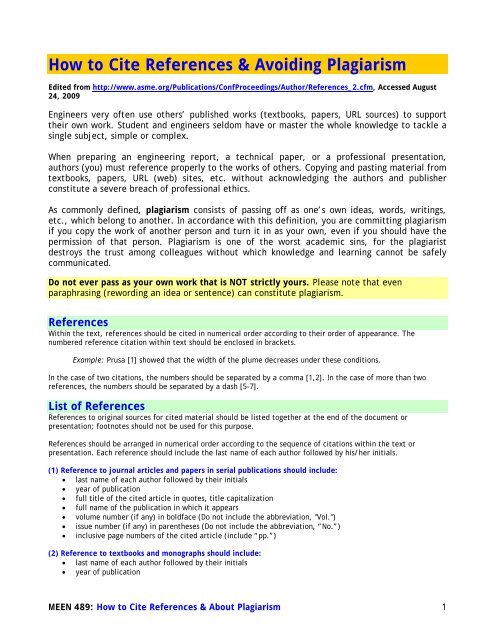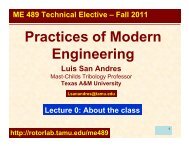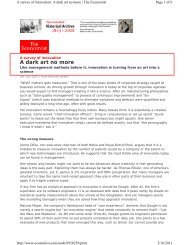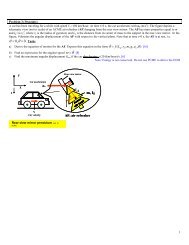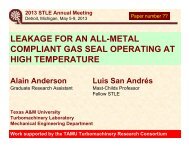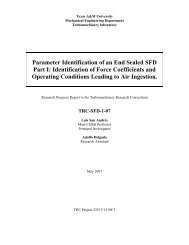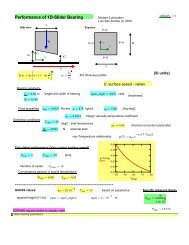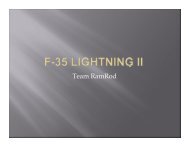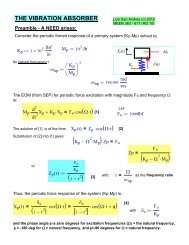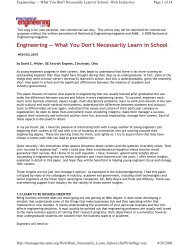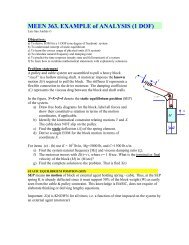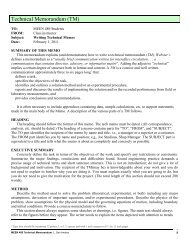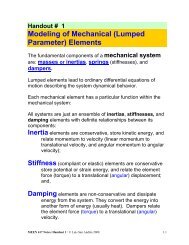ASME How to Cite references
ASME How to Cite references
ASME How to Cite references
Create successful ePaper yourself
Turn your PDF publications into a flip-book with our unique Google optimized e-Paper software.
<strong>How</strong> <strong>to</strong> <strong>Cite</strong> References & Avoiding Plagiarism<br />
Edited from http://www.asme.org/Publications/ConfProceedings/Author/References_2.cfm, Accessed August<br />
24, 2009<br />
Engineers very often use others’ published works (textbooks, papers, URL sources) <strong>to</strong> support<br />
their own work. Student and engineers seldom have or master the whole knowledge <strong>to</strong> tackle a<br />
single subject, simple or complex.<br />
When preparing an engineering report, a technical paper, or a professional presentation,<br />
authors (you) must reference properly <strong>to</strong> the works of others. Copying and pasting material from<br />
textbooks, papers, URL (web) sites, etc. without acknowledging the authors and publisher<br />
constitute a severe breach of professional ethics.<br />
As commonly defined, plagiarism consists of passing off as one’s own ideas, words, writings,<br />
etc., which belong <strong>to</strong> another. In accordance with this definition, you are committing plagiarism<br />
if you copy the work of another person and turn it in as your own, even if you should have the<br />
permission of that person. Plagiarism is one of the worst academic sins, for the plagiarist<br />
destroys the trust among colleagues without which knowledge and learning cannot be safely<br />
communicated.<br />
Do not ever pass as your own work that is NOT strictly yours. Please note that even<br />
paraphrasing (rewording an idea or sentence) can constitute plagiarism.<br />
References<br />
Within the text, <strong>references</strong> should be cited in numerical order according <strong>to</strong> their order of appearance. The<br />
numbered reference citation within text should be enclosed in brackets.<br />
Example: Prusa [1] showed that the width of the plume decreases under these conditions.<br />
In the case of two citations, the numbers should be separated by a comma [1,2]. In the case of more than two<br />
<strong>references</strong>, the numbers should be separated by a dash [5-7].<br />
List of References<br />
References <strong>to</strong> original sources for cited material should be listed <strong>to</strong>gether at the end of the document or<br />
presentation; footnotes should not be used for this purpose.<br />
References should be arranged in numerical order according <strong>to</strong> the sequence of citations within the text or<br />
presentation. Each reference should include the last name of each author followed by his/her initials.<br />
(1) Reference <strong>to</strong> journal articles and papers in serial publications should include:<br />
• last name of each author followed by their initials<br />
• year of publication<br />
• full title of the cited article in quotes, title capitalization<br />
• full name of the publication in which it appears<br />
• volume number (if any) in boldface (Do not include the abbreviation, "Vol.")<br />
• issue number (if any) in parentheses (Do not include the abbreviation, “No.”)<br />
• inclusive page numbers of the cited article (include “pp.”)<br />
(2) Reference <strong>to</strong> textbooks and monographs should include:<br />
• last name of each author followed by their initials<br />
• year of publication<br />
MEEN 489: <strong>How</strong> <strong>to</strong> <strong>Cite</strong> References & About Plagiarism 1
• full title of the publication in italics<br />
• publisher<br />
• city of publication<br />
• inclusive page numbers of the work being cited (include “pp.”)<br />
• chapter number (if any) at the end of the citation following the abbreviation, “Chap.”<br />
(3) Reference <strong>to</strong> individual conference papers, papers in compiled conference proceedings, or any other<br />
collection of works by numerous authors should include:<br />
• last name of each author followed by their initials<br />
• year of publication<br />
• full title of the cited paper in quotes, title capitalization (see examples)<br />
• individual paper number (if any)<br />
• full title of the publication in italics<br />
• initials followed by last name of edi<strong>to</strong>rs (if any), followed by the abbreviation, “eds.”<br />
• publisher<br />
• city of publication<br />
• volume number (if any) in boldface if a single number, include, “Vol.” if part of larger identifier (e.g.,<br />
“PVP-Vol. 254”)<br />
• inclusive page numbers of the work being cited (include “pp.”)<br />
(4) Reference <strong>to</strong> theses and technical reports should include:<br />
• last name of each author followed by their initials<br />
• year of publication<br />
• full title in quotes, title capitalization<br />
• report number (if any)<br />
• publisher or institution name, city<br />
(5) Reference <strong>to</strong> URL sites (Uniform Resource Loca<strong>to</strong>rs), i.e., www sites<br />
• Author or source of the web page, if you can find a name. Last name of each author followed by their<br />
initials<br />
• Year of creation of URL, if known<br />
• Web page title, in quotations<br />
• website title<br />
• URL of the website<br />
• date (m/d/y) website visited, in brackets.<br />
Example: LastName, I., 2002, “Page U,” Glossary of Internet Terms,<br />
http://www.matisse.net/files/glossary.html (accessed May 10, 2003).<br />
Sample References<br />
[1] Ning, X., and Lovell, M. R., 2002, “On the Sliding Friction Characteristics of Unidirectional Continuous FRP<br />
Composites,” <strong>ASME</strong> J. Tribol., 124(1), pp. 5-13.<br />
[2] Barnes, M., 2001, “Stresses in Solenoids,” J. Appl. Phys., 48(5), pp. 2000–2008.<br />
[3] Jones, J., 2000, Contact Mechanics, Cambridge University Press, Cambridge, UK, Chap. 6.<br />
[4] Lee, Y., Korpela, S. A., and Horne, R. N., 1982, “Structure of Multi-Cellular Natural Convection in a Tall Vertical<br />
Annulus,” Proc. 7th International Heat Transfer Conference, U. Grigul et al., eds., Hemisphere, Washing<strong>to</strong>n, DC, 2,<br />
pp. 221–226.<br />
[5] Hashish, M., 2000, “600 MPa Waterjet Technology Development,” High Pressure Technology, PVP-Vol. 406, pp.<br />
135-140.<br />
[6] Watson, D. W., 1997, “Thermodynamic Analysis,” <strong>ASME</strong> Paper No. 97-GT-288.<br />
MEEN 489: <strong>How</strong> <strong>to</strong> <strong>Cite</strong> References & About Plagiarism 2
[7] Tung, C. Y., 1982, “Evaporative Heat Transfer in the Contact Line of a Mixture,” Ph.D. thesis, Rensselaer<br />
Polytechnic Institute, Troy, NY.<br />
[8] Kwon, O. K., and Pletcher, R. H., 1981, “Prediction of the Incompressible Flow Over A Rearward-Facing Step,”<br />
Technical Report No. HTL-26, CFD-4, Iowa State Univ., Ames, IA.<br />
[9] Smith, R., 2002, “Conformal Lubricated Contact of Cylindrical Surfaces Involved in a Non-Steady Motion,” Ph.D.<br />
thesis, http://www.cas.phys.unm.edu/rsmith/homepage.html (accessed June 1, 2005)<br />
[10] Enzer, M., 2002, “Page U,” Glossary of Internet Terms, http://www.matisse.net/files/glossary.html<br />
(accessed May 10, 2003).<br />
Prepared by Luis San Andrés for<br />
MEEN 489 Class: Modern Practices of Engineering<br />
August 24, 2009; rev 1. January 19, 2011<br />
MEEN 489: <strong>How</strong> <strong>to</strong> <strong>Cite</strong> References & About Plagiarism 3


